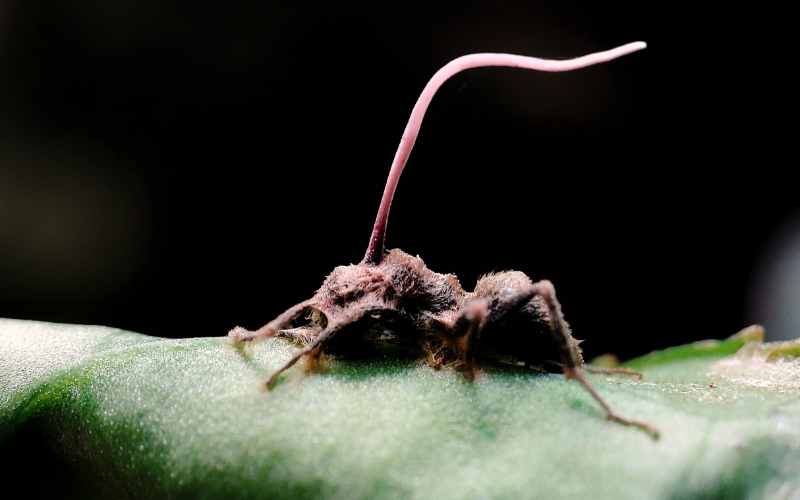Tandem Global's Latest Blog Post Delves into the Fascinating World of Parasite Manipulation
BETHESDA, MD / ACCESS Newswire / October 31, 2025 / What if I told you zombies are real? And no, not the ones you see on movie screens. I'm talking about nature's zombies, real organisms hijacked and controlled by other living things. This phenomenon, often referred to as parasite manipulation, is found in most ecosystems throughout the world. Parasite manipulation can take shape in many forms, from subtle behavioral changes to dramatic transformations that make the host look and act like something out of a horror film.

In these strange relationships, the "zombie" isn't dead, at least not yet, but it's no longer in full control of its own body. Tiny fungi, bacteria, and worms can essentially rewrite the host's brain, forcing it to behave in ways that benefit the parasite rather than the animal itself. A caterpillar might climb to the tip of a plant, paralyzed by a fungus, only to be consumed from within as the fungus spreads its spores. Crickets can be compelled to jump to their grave, where they are then eaten alive by microscopic puppeteers.
Parasites often produce chemicals that mimic or interfere with their host's natural hormones and neurotransmitters. The result is a perfectly choreographed takeover. The host becomes a tool, unknowingly carrying out the parasite's reproductive or survival agenda. Unlike fictional zombies, these manipulations are highly specific. Each parasite knows exactly how to influence its host to maximize its own chance of survival, whether that means altering movement or feeding behavior.
But what does this look like in practice? How does a fungus convince an ant to march to its death, or a parasitic worm drive a cricket to take its own life? Scientists still don't fully understand how these parasites control their hosts, but their mysteries open the door to the strange world of nature's real-life zombies.
For instance, the fungus Ophiocordyceps, often dubbed the "zombie-ant fungus", may appear to be just another harmless organism, but its relationship with ants is nothing short of terrifying. The fungus attaches to the body of an ant, secreting enzymes that dissolve the ant's tough exoskeleton, allowing the fungus to penetrate and begin the infection. Once an ant is infected, the fungus slowly takes over its central nervous system, manipulating it to leave the safety of its colony and aimlessly climb vegetation. Once high enough, the ant clamps down on a leaf or twig in what scientists call a "death grip," where it ultimately dies as the fungus eats through its body, releasing spores to infect the next unlucky ant.
Another unsettling example comes from Nematomorph hairworm parasites that live inside grasshoppers and crickets. The worm begins its life in water, hatching as a tiny larva that is ingested by small aquatic organisms like aquatic isopods and amphipods. When a cricket or grasshopper ingests one of these small organisms, the worm enters its body and begins a slow-growing invasion. Over the next few months, the long, thin worm grows inside the insect, preparing for reproduction. When the worm reaches maturity, it releases chemicals that literally rewire the cricket's brain. The cricket suddenly feels an irresistible urge to jump into water. Once the cricket drowns, the hairworm emerges from the cricket's body and enters the water to continue its life cycle, leaving the cricket's body as an empty shell.
The green-banded broodsac flatworm uses an interesting strategy to complete its life cycle. It begins by infecting a snail, its first host, where it eventually moves into the snail's eye stalks. There, the parasite causes the stalks to swell and pulse with bright green and yellow bands that resemble small caterpillars, an appetizing target for birds. The infection also changes the snail's behavior. Instead of hiding in the shade, the snail becomes unusually active and crawls into the open during the day, making itself more visible to predators. When a bird eats the infected snail, the flatworm reaches its final host and reproduces inside the bird's digestive system. In this way, the parasitic flatworm uses the snail as both transportation and bait to attract its intended target.
Unlike the green-banded broodsac, the Glyptapanteles take on a more direct approach. This parasitic wasp is found on every continent except Antarctica and takes manipulation to an entirely new level. It lays its eggs inside the caterpillar of the geometrid moth, where the larvae feed on the host from within. When they are ready to pupate, the larvae consume the host from within and emerge to spin cocoons on surrounding vegetation. Remarkably, the caterpillar doesn't immediately die. Instead, it undergoes a dramatic behavioral transformation, standing guard over the newly formed pupae. The caterpillar stops moving and feeding, positioning itself close to the pupae, and when threatened, violently swinging its head to deter potential predators. This self-sacrificial behavior significantly reduces predation on the pupae, increasing their survival rates. However, the caterpillar's fate is sealed; it dies shortly after the wasp larvae emerge as adults, having unwittingly served as a bodyguard.
In observing nature's zombies, we understand the reality of a world where autonomy is fragile. They're reminders that in nature, control is an illusion, and every creature, including us, dances to the rhythm of unseen forces.
About Tandem Global
Tandem Global (formerly WHC and WEC), provides the know-how and the network to move business and the environment forward, together. Across sectors and at all levels of its 100+ member organizations, Tandem Global connects leading thinking with practical solutions that positively impact climate, nature, and water. From field operations to boardrooms and beyond, corporate leaders turn to Tandem Global for impact strategies and resilient solutions that can support a better future. tandemglobal.org.
View additional multimedia and more ESG storytelling from Tandem Global on 3blmedia.com.
Contact Info:
Spokesperson: Tandem Global
Website: https://www.3blmedia.com/profiles/tandem-global
Email: info@3blmedia.com
SOURCE: Tandem Global
View the original press release on ACCESS Newswire:
https://www.accessnewswire.com/newsroom/en/business-and-professional-services/the-strange-lives-of-natures-zombies-1094465